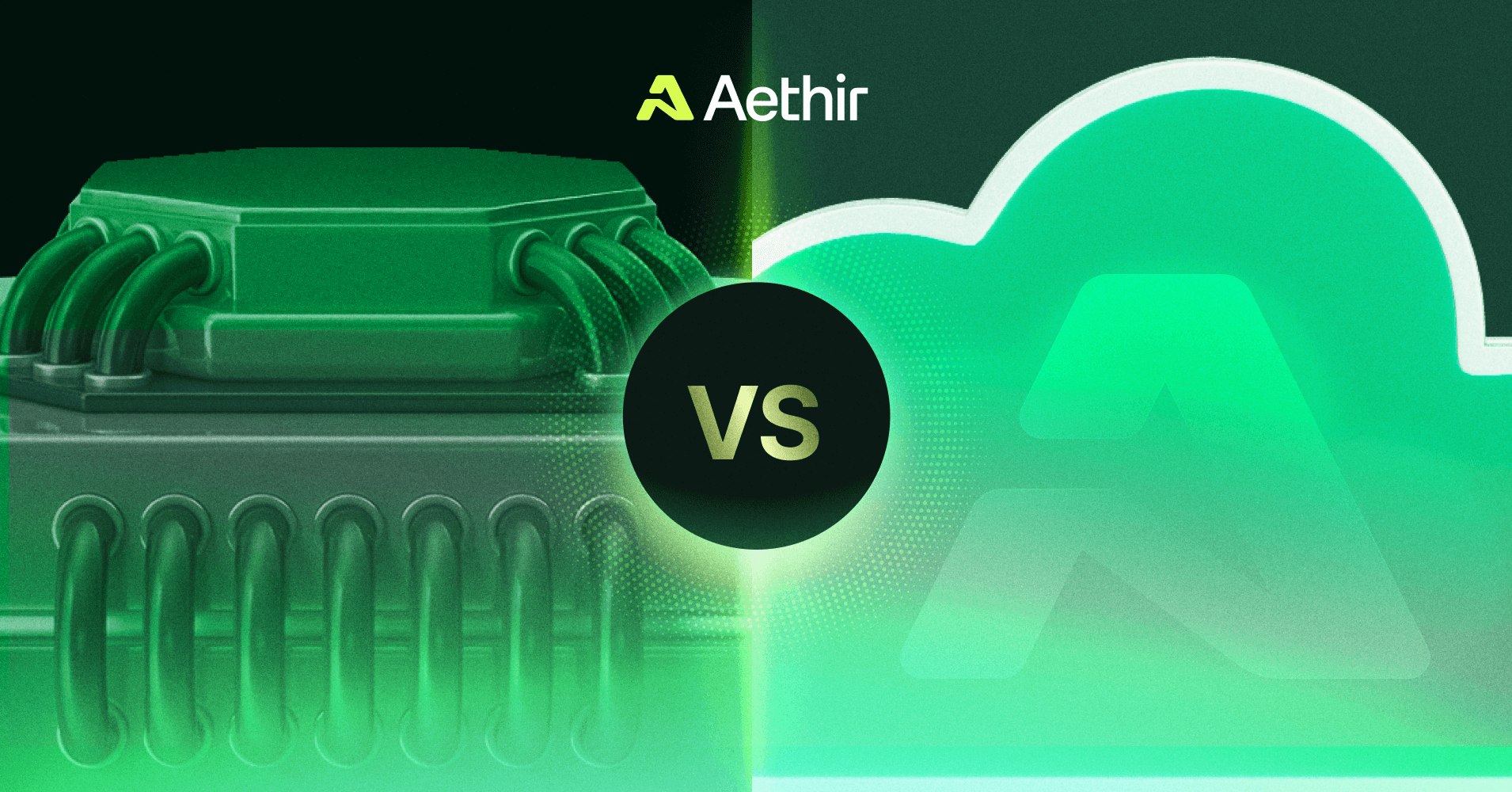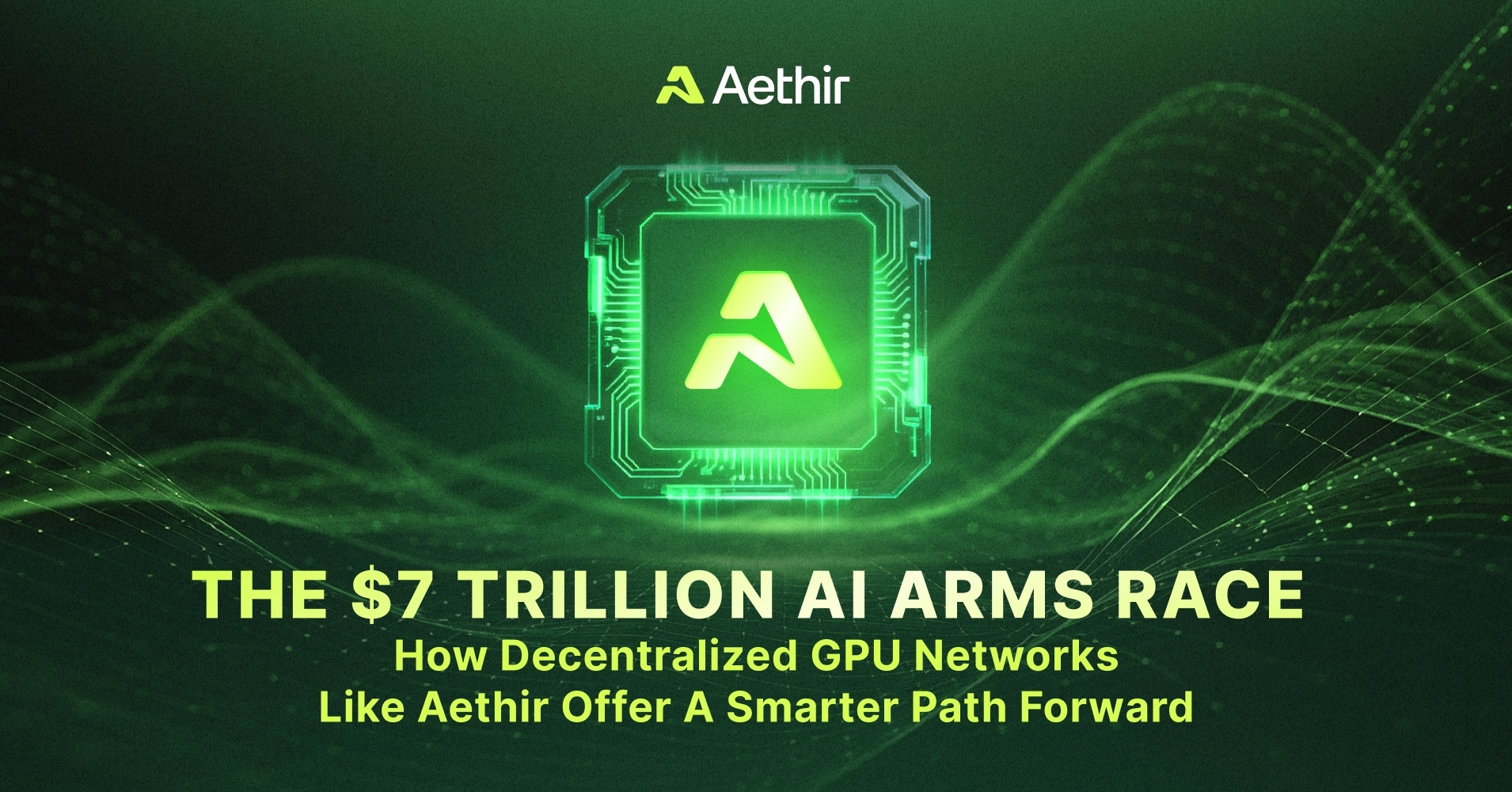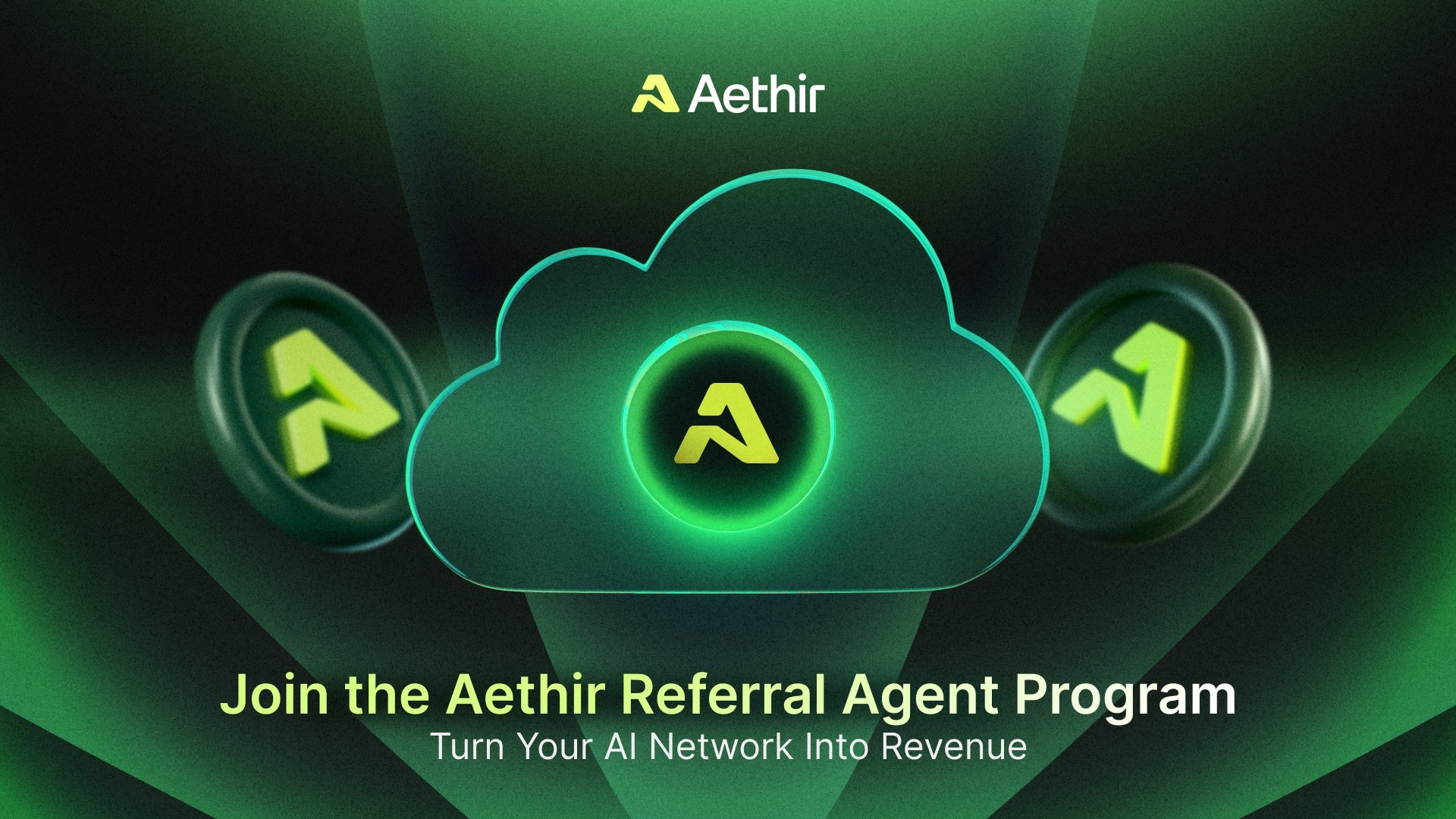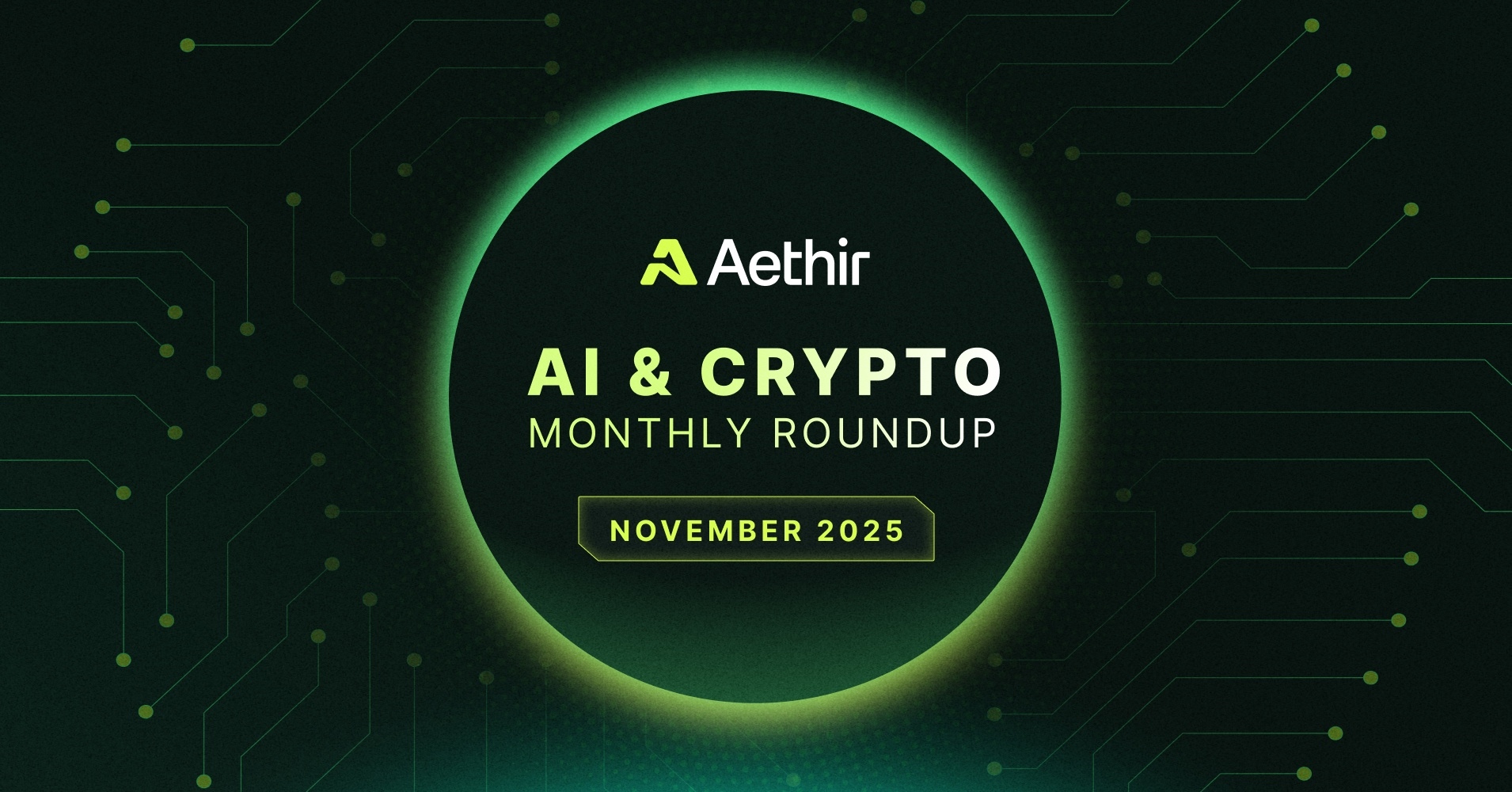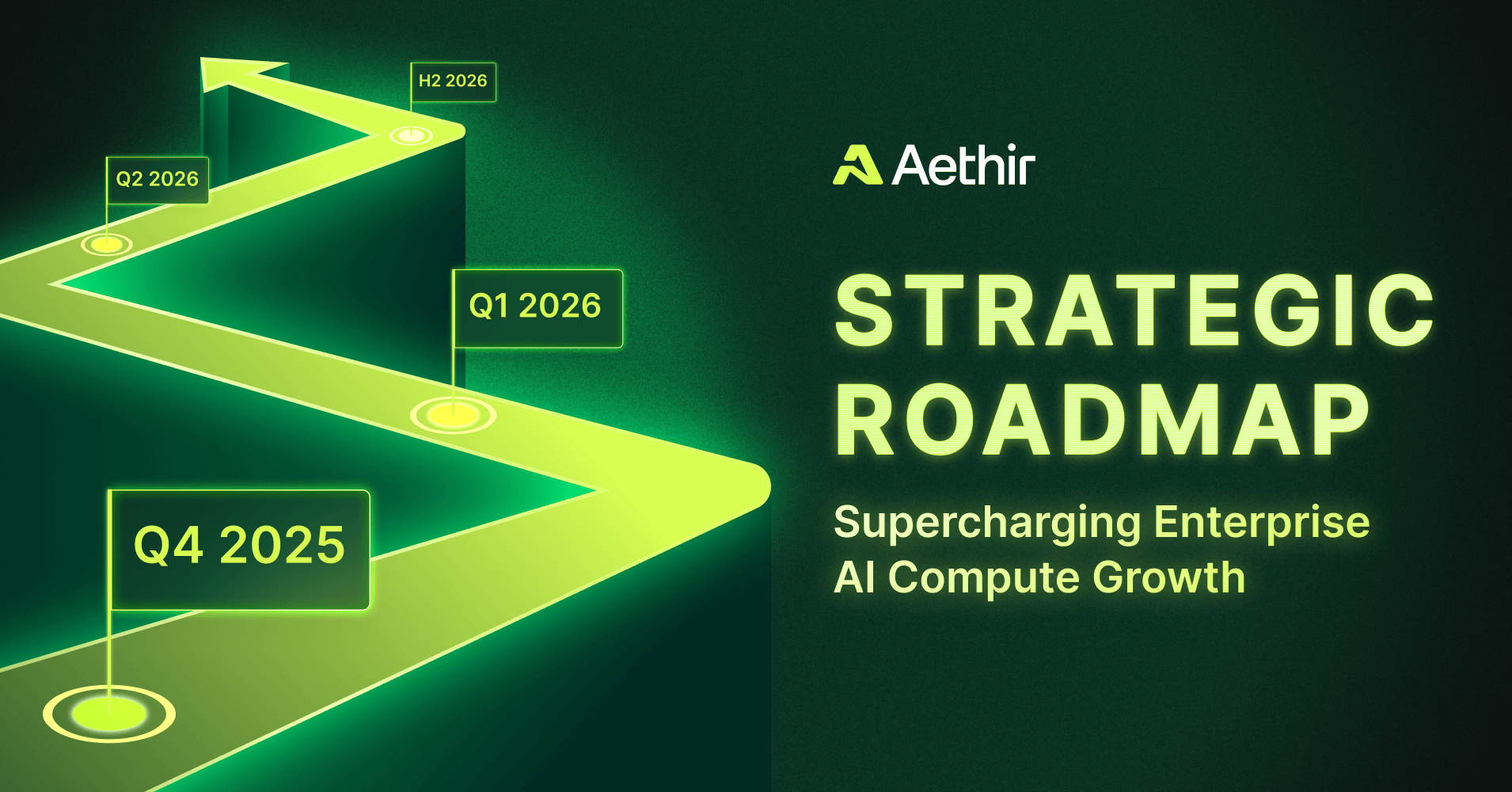主要なポイント
- 5000億ドル規模のクラウドコンピューティング市場は、AWS、Google Cloud、Microsoft Azureといった中央集権型のハイパースケーラープロバイダーによって長らく支配されてきました。
- しかし、従来のクラウドは、柔軟で高性能なGPUコンピュートを要求する現代のAIワークロードへの対応に苦慮しています。
- Aethirの分散型GPUクラウドはこのギャップを埋め、93カ国にわたる435,000以上のGPUコンテナによって、遊休GPUをエンタープライズグレードのインフラに変えます。
- クライアントはパフォーマンス、柔軟性、費用対効果を手に入れ、一方、クラウドホストは所有権やオーバーヘッドなしに遊休GPUを収益化することで収益を得ます。
Aethirクラウドホストになるメリットについてはこちらをご覧いただき、このフォームから遊休GPUの収益化を申請してください。
クラウドの再考:中央集権型 vs 分散型
従来のクラウドはデジタル時代を築き上げましたが、AIの未来には対応できていません。ハイパースケーラーは、高コストな中央集権型データセンター、限られた容量、高いオーバーヘッドに依存しています。
Aethirがもたらす違い
Aethirの分散型GPUクラウドは、独立したクラウドホストのグローバルコミュニティを通じて完全に運営されています。このアプローチは、設備投資(CapEx)のボトルネックを排除し、ベアメタル性能を提供し、企業が使用したコンピュート分だけを支払うことを可能にします。
クラウドコンピューティングの未来は、AWSを打ち負かすことではなく、AWSがサービスを提供できない顧客にサービスを提供することにあります。
GPUクラウドプロバイダーの経済性
中央集権型クラウドの経済性(レガシーモデル)
ハイパースケーラーのクラウドは以下に依存しています:
- 巨額の設備投資(四半期で10億ドル超)
- 最適なGPU利用率(65~75%)に依存する30~40%の売上総利益
- 未利用のGPUやデータセンターに対する上昇し続ける維持コスト
- ベンダーロックイン、データ転送料金(エグレスフィー)、スケーリングの遅延
AIの導入が急増するにつれ、これらの中央集権型モデルは供給の限界と価格設定の非効率性を露呈し、スタートアップは代替のコンピュートソリューションを探さざるを得なくなっています。
分散型GPUの経済性(新興モデル)
Aethirの分散型ネットワークは、この経済性を覆します:
- クラウドホストが遊休GPUを提供し、エンタープライズグレードのコンピュートに貢献します。
- 91,000以上のチェッカーノードが、安定した稼働時間と検証可能なコンピュート品質を保証します。
- ATHトークンによるインセンティブが、オペレーター、クライアント、インフラ経済の足並みを揃えます。
このトークン化されたコミュニティ主導のモデルは、従来のクラウドのオーバーヘッドを排除し、より多くの参加者が加わるにつれて有機的にスケールします。
Aethirの分散型クラウドが優位な理由
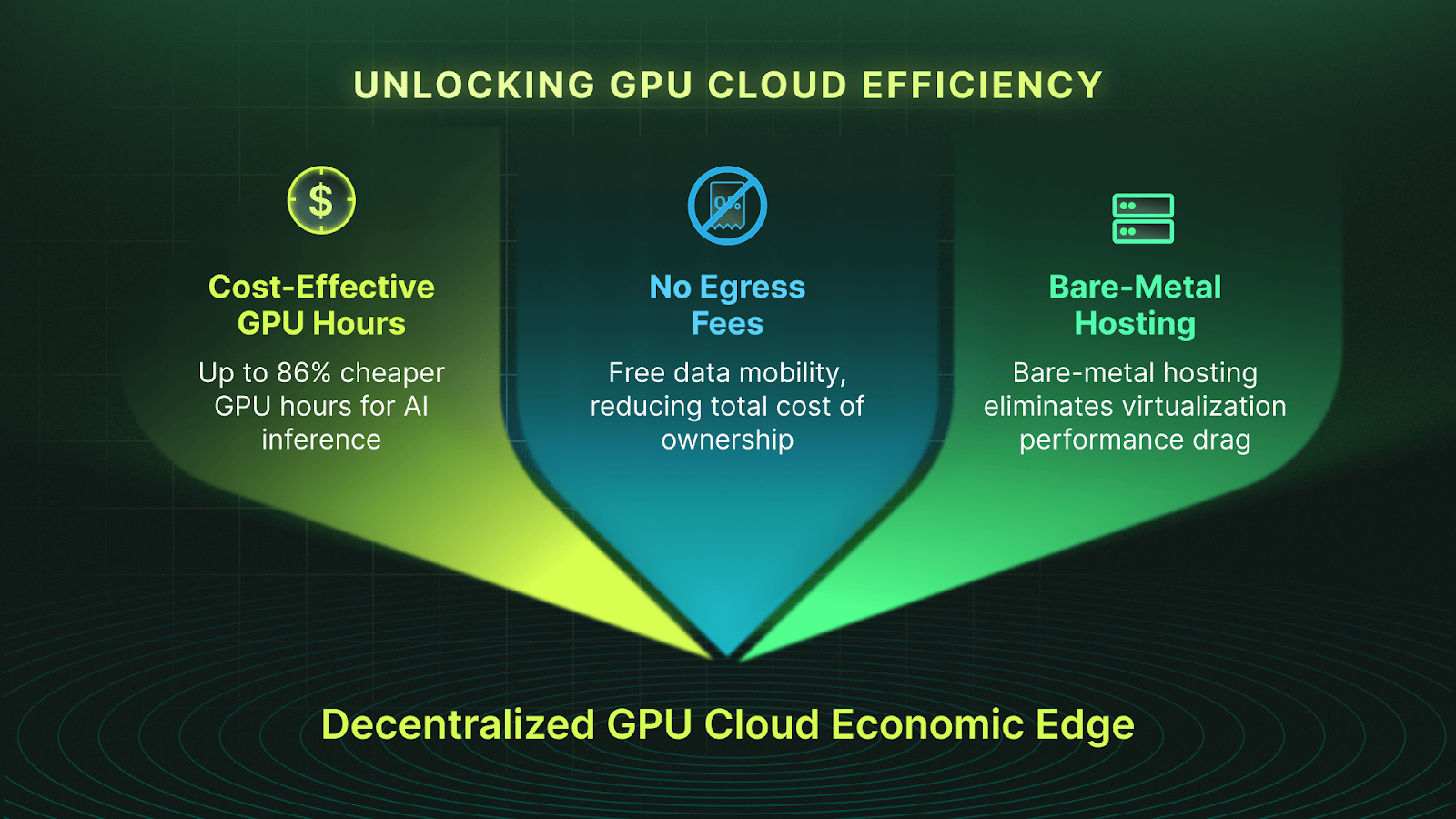
分散型GPUクラウドホスティングは、従来のGPUコンピューティングに代わる費用対効果の高い選択肢を提供し、特に柔軟なコンピューティングインフラを求める革新的なAI企業やスタートアップに適しています。
AethirのクラウドホストによるGPUインフラは、中央集権型プロバイダーに対して複数の主要な利点を提供します。
コスト効率
- AethirのベアメタルGPUは、NVIDIA H100の推論において、AWSの同等品よりも最大86%安価です。
- データセンターへの設備投資(CapEx)が不要です。
- 仮想化手数料やパフォーマンス低下(パフォーマンス税)がありません。
- データ転送料金(エグレスチャージ)が無料:データ転送は無料で無制限です。
スケーラビリティ
- グローバルなGPUコンテナを活用し、Aethirはローカライズされたコンピュートを24~48時間以内に動的に割り当てます。従来のセットアップでは1ヶ月かかります。
柔軟性
- 200以上のグローバルな拠点を持つAethirは、コンピュートとクライアント間の物理的な近接性を通じて超低遅延を保証します。
透明性
- クライアントは使用した分だけを支払います。隠れたコストやロックインはなく、完全に検証可能なSLA(サービス品質保証)が提供されます。
これらの要因が組み合わさることで、AI、レンダリング、リアルタイムのワークロードをスケーリングする企業にとって、予測可能で透明性の高い経済性が実現します。クラウドホストとして、今すぐ遊休GPUの収益化を始め、Aethirの分散型GPUクラウドに参加しましょう。こちらから応募してください。
市場ポジショニング:戦略的差別化の技術
中央集権型または分散型のクラウドインフラが最適なパフォーマンスを提供できる特定のユースケースを区別することが不可欠です。
従来型プロバイダーが優位な領域
AWSやAzureのような中央集権型クラウドプロバイダーは、コンプライアンス重視で企業内に固定化された垂直市場において依然として無敵であり、従来の大規模クラウドコンピューティングクライアントに必要な安定性を提供しています。
- 規制産業(金融、防衛、ヘルスケア)
- マネージドPaaS(Platform-as-a-Service)とエコシステムの統合
- エンタープライズ向けの契約管理と認証
分散型プロバイダーが優位な領域
Aethirの分散型GPUクラウドは、その逆の条件、すなわちクライアントのニーズに適応する柔軟で費用対効果の高いインフラが不可欠な領域で強みを発揮します。
- GPU使用率の高いAIおよびレンダリングのワークロード(中央集権型クラウドより最大86%安価)。
- ハイパースケーラーがカバーしていない未対応地域へのエッジ展開により、超低遅延を実現。
- 24~48時間以内の迅速なプロビジョニング:Aethirはわずか48時間で合理化されたコンピュートアクセスをクライアントに提供できます。
- 単一障害点を持つ中央集権型データセンターの代わりに、独立したクラウドホストが提供するローカライズされたGPUサーバーによるデータ主権。
分散型GPUクラウド革命
AethirのGPUクラウドは、成長するAIセクターに費用対効果の高い分散型クラウドコンピューティングサービスを提供できます。
- Aethirのクラウドホストは200以上の拠点に分散しており、Aethirのインデクサーがクライアントを物理的に最も近く、技術的に最も適切な利用可能なGPUとペアリングすることを可能にします。
- クライアントは、柔軟で効率的、かつ費用対効果の高い分散型クラウドコンピューティングを享受できます。
- クラウドホストは、遊休GPUをAethirネットワークに接続するだけで、そのサービスに対するATH報酬を獲得し、コンピュートプロバイダーとして安定したスケーラブルな収益を生み出します。
こちらの詳細ガイドでAethirクラウドホストになる方法を学び、こちらからコンピュートプロバイダーとしてAethirのネットワークに応募してください。
重要な「堀」(競争優位性)
従来型と分散型のクラウドコンピューティングモデルは異なる「堀」を持っており、分散コンピューティングモデルが、特にAIセクターにおいて、現代のコンピュート集約型エンタープライズワークロードにより適していることを示しています。
従来型クラウドプロバイダーの「堀」
ハイパースケーラーとしばしば呼ばれる従来型クラウドプロバイダーは、様々な戦略を通じて、重大な参入障壁と競争上の優位性を確立してきました。
- エコシステムによるロックイン戦略: ハイパースケーラーは、独自のAPI、データベース、開発ツールの広大なエコシステムを構築してきました。このベンダーロックイン戦略は、他のコンピュートプロバイダーへの移行を抑制しつつ、予測可能な経常収益を確保します。
- コンプライアンスと認証の障壁: ハイパースケーラーのクラウドプロバイダーは、ISO 27001, SOC 2, HIPAA, FedRAMPなどの重要な認証を保持していることがよくあります。これらの認証には、長年の監査、広範な文書化、インフラの拡張が必要であり、エンタープライズ顧客にデータセキュリティと規制遵守に関する安心感を提供します。
- 販売およびサポートインフラ: 従来型クラウドプロバイダーは、巨大なグローバルエンタープライズ営業チーム、専任のカスタマーサクセスマネージャー、複数の言語とタイムゾーンにまたがる24時間365日のサポートチャネルを維持しています。この広範なサポートネットワークは、大企業にとって大きな利点です。
- ブランドの信頼とリスク軽減: 主要な中央集権型クラウドプロバイダーは、信頼できるコンピューティングインフラプロバイダーとして、かなりのコミュニティの信頼、認知度の高いブランドアイデンティティ、そして肯定的な評判を築き上げてきました。この確立された信頼は、大口クライアントを引き付け、維持するための重要な要素です。
分散型GPUクラウドプロバイダーの「堀」
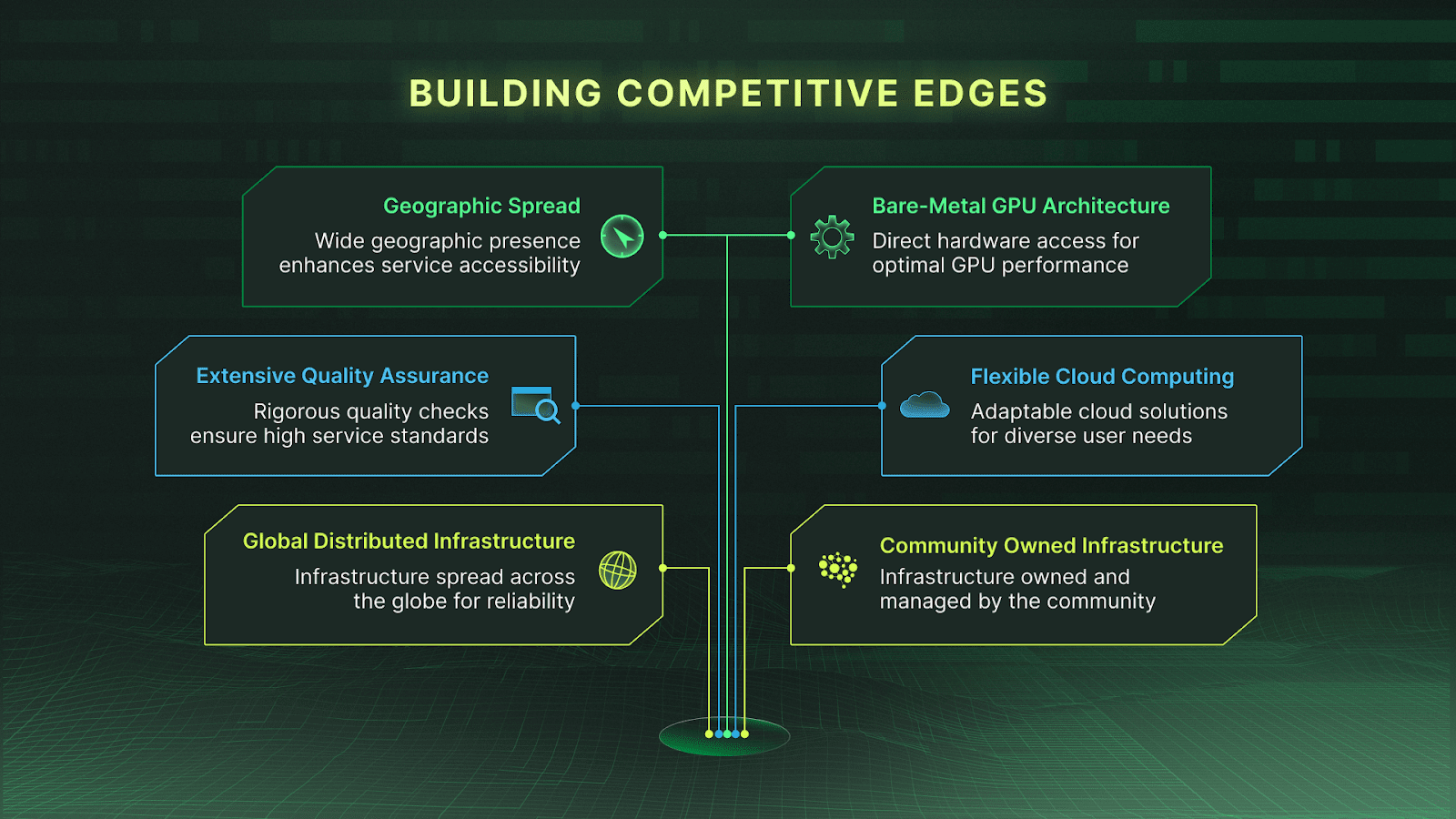
コンピュートリソースとサービスを中央集権化する代わりに、Aethirの分散型GPUクラウドモデルは、世界中に分散した多数の独立したクラウドホストのネットワーク効果に依存しています。
- グローバルに分散したコミュニティ所有のインフラ: Aethirは、世界中の200以上の拠点に435,000以上のハイエンドGPUコンテナを誇り、回復力が高く広範にアクセス可能なネットワークを構築しています。
- コミュニティ所有のインフラとトークンインセンティブ: クラウドホストは、そのサービスに対してATHトークンで報酬を受け取り、強力なコミュニティを育み、参加を奨励します。
- 広範な品質保証システム: 91,000以上のチェッカーノードが、すべてのGPUコンテナを常に監視し、クライアントが常に最適なサービス品質を受けられるように保証します。
- 柔軟な分散型クラウドコンピューティングアプローチ: Aethirは分散型GPUコンピュートマーケットプレイスとして機能し、特定のニーズに基づいて最適なベンダー(クラウドホスト)とクライアントをペアリングします。
- 地理的広がり: グローバルなクラウドホストネットワークを運営することで、Aethirは地理的な制約なしに、グローバルに分散したチームを持つクライアントに効率的にサービスを提供できます。
- ベアメタルGPUアーキテクチャ: AethirのベアメタルGPUサービスは、クライアントに最大のスループットを保証し、クラウドホストに95%以上という高い平均GPU利用率をもたらします。
Aethirの重要なコンピュートプロバイダーとしての「堀」
クライアントがコンピュートプロバイダーを選ぶ際に大きな影響を与える、Aethirの重要な「堀」を見てみましょう。
- 低CAC(顧客獲得コスト)のコミュニティベースのユーザー成長: Aethirの分散型GPUクラウドモデルは、インセンティブの調整とコミュニティエンゲージメントを通じてユーザーベースを成長させ、高価な広告キャンペーンの必要性を排除します。
- 透明性の高い価格設定と公正なガバナンスによる高いLTV(顧客生涯価値): Aethirには透明性の高い価格設定モデルがあります。クライアントは実際に使用したコンピュート分しか支払わないため、信頼関係の構築と長期的な顧客ロイヤルティの確立に役立ちます。
- コンピュートプロバイダーへのトークンインセンティブ: AethirのクラウドホストはATHを獲得し、稼働時間の最大化とサービス品質の向上を奨励されます。このアプローチは、ユーザーがエコシステムへの投資を継続することを確実にし、公正さに根差した持続可能な生涯価値を生み出します。
- 倫理的なスイッチングコスト: Aethirの分散型クラウドコンピューティングエコシステムは、ベンダーロックインによってクライアントを閉じ込めることはありません。Aethirは、プレミアムな品質のパフォーマンス、オープン性、信頼性を通じてクライアントを維持します。
パートナーシップのパラドックス:協力と競争の戦略
ライバル企業間の競争と協力はより多くの価値を生み出します。クラウドコンピューティングセクターは、そのような戦略のための様々な機会を提供します。
ハイパースケーラーと提携すべき時
ハイブリッドクラウド・オーケストレーションは、分散型クラウドサービスと従来のクラウドコンピューティングを組み合わせる、ますます一般的になっているコンピューティングモデルです。AI企業は、Aethirの分散型GPUネットワーク上で柔軟で費用対効果の高いコンピューティングを必要とするGPU集約型ワークロードを展開しつつ、AWSのような従来型クラウド上でコンプライアンスストレージを維持するといった、両サービスの長所を活用できるようになりました。
さらに、中央集権型クラウドプロバイダーは、分散型クラウド企業とオーバーフロー容量契約を結ぶことで、予期せぬ需要急増時に信頼性が高く多目的な分散型クラウドコンピューティングのサポートを確保できます。
分散型クラウドアライアンスの構築
分散型インフラプロバイダーとの提携はAethirの主要な協力戦略であり、AI Unbundled Allianceのような業界全体の主要な分散型協力関係につながっています。このアライアンスを通じて、Aethirの分散型GPUネットワークは、DePIN、AI、Web3セクター全体の業界リーダーと協力し、AI開発者やイノベーターにあらゆるインフラサポートを提供しています。
分散型GPUクラウド拡大のためのチャネル戦略
Aethirの分散型クラウドスケーリング戦略は、巨額の広告予算の代わりに、地域のシステムインテグレーターとの協力を活用し、信頼できるローカルな仲介者を通じてエンタープライズクライアントへの扉を開きます。Impossible Cloud Network、Botanika、SuperScale、ReturnEntertainmentといった企業とのAethirのパートナーシップは、リソースのプールと協力がいかにリーチを最大化できるかを示す好例です。これらのパートナーシップにより、AethirはAIやWeb3からゲーミングまで、さまざまな業界で新規クライアントを獲得し、サービスを提供することが可能になっています。
顧客獲得:分散型GPUクラウド vs ハイパースケーラークラウドの戦術
Aethirのような革新的な分散型GPUクラウドモデルと、AWSのような従来のハイパースケーラークラウドとでは、顧客獲得の戦術はかなり異なります。
直接対決の罠
分散型GPUクラウドコンピューティングプロバイダーは、AWSやAzureのようなプロバイダーの規模の大きさゆえに、マーケティング予算、R&D、グローバルな販売網の点でハイパースケーラーを上回る支出はできません。中央集権型クラウドのリーダーたちと広告費やマーケティングで競争しようとするのは負け戦ですが、実際には、分散型クラウドインフラがプレイする必要のないゲームなのです。
分散型クラウドホスティングの挑戦者戦略
中央集権型クラウドのリーダーと直接競争する代わりに、Aethirの分散型GPUクラウドホスティングモデルは、GPU集約型ワークロードにとってより良い選択肢となる主要な強みと特性を強調します。分散型クラウドアーキテクチャは、ハイパースケーラーには真似できない機敏性、透明性、応答性を際立たせます。
コミュニティ主導の成長モデルは、分散型GPUクラウドのユーザー獲得に不可欠です。Aethirには、クラウドホスト、チェッカーノードオペレーター、ATHステーカー、そして150以上のパートナーとクライアントからなる盛んなエコシステムがあり、彼らが業界全体に分散型クラウドの卓越性を広めています。
プロバイダーのための価格心理学
Aethirの分散型GPUクラウドホスティングモデルは、NVIDIA H100のようなAI対応の高度なGPUチップに対して、他に負けないサービス価格を提供します。しかし、低価格だけで競争することはコモディティ化を招く可能性があります。だからこそAethirは、中央集権型クラウドのリーダーよりもはるかに迅速なデプロイメントと共に、95%+という高いGPU利用率で、そのGPUコンピューティングサービスが明確な価値を提供することを強調しています。
クライアントが使用したコンピュート分だけを請求するシンプルで分かりやすい価格構造を提供することで、Aethirの分散型クラウドホスティングモデルは新規ユーザーを引き付け、信頼を構築します。データ転送料金(エグレスフィー)がないことで、分散型クラウドコンピューティングは、クラウド業界で最も嫌われているコストの一つを排除しています。
テクノロジー戦略:イノベーション vs 統合
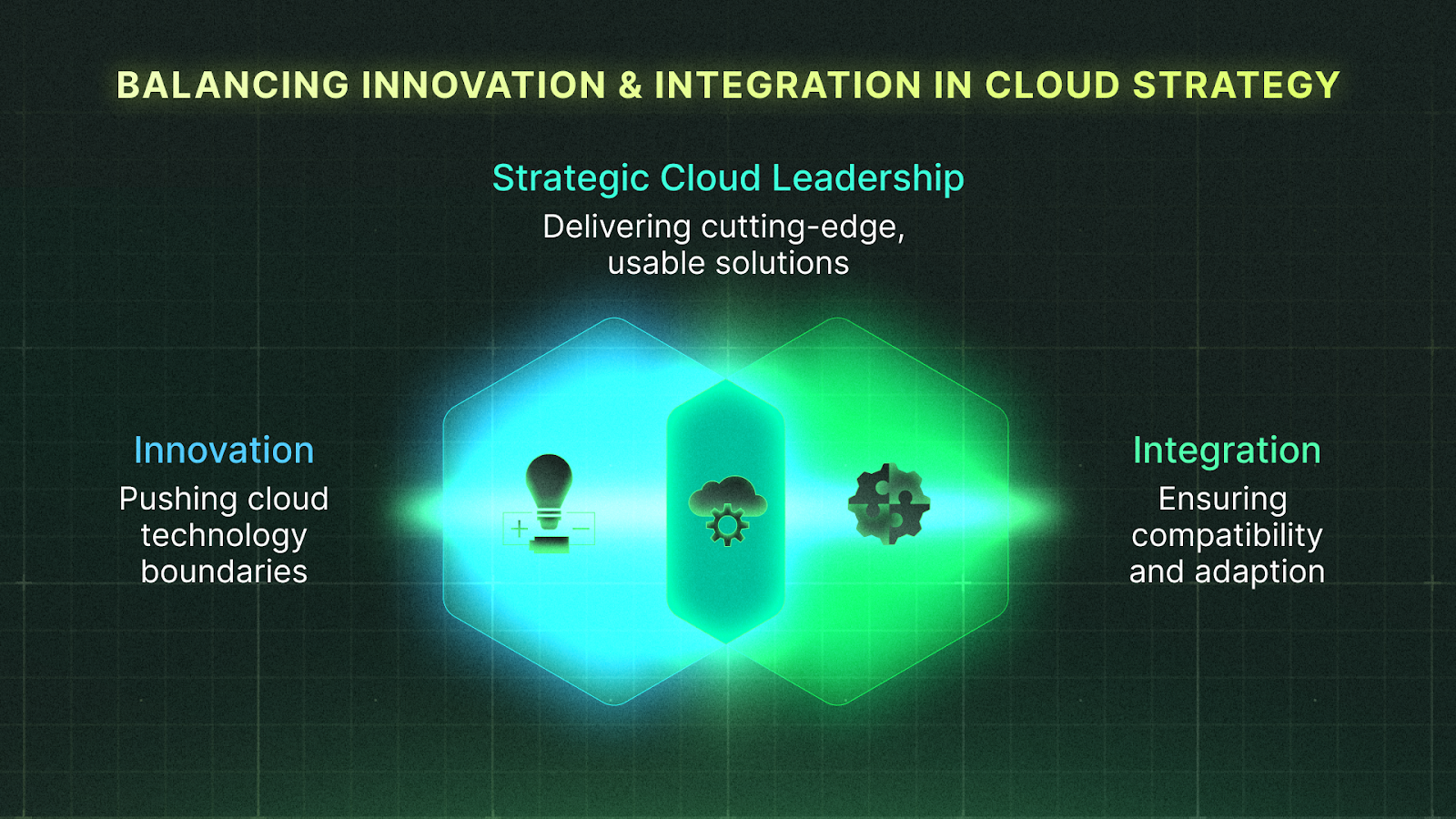
分散型GPUクラウドアーキテクチャは、分散ネットワークモデルを通じてクラウドコンピューティングを革新しますが、セキュリティ、パフォーマンス、信頼性を最大化するためにいつインフラを統合すべきかを知ることも不可欠です。
イノベーションと統合のバランスをとることで、分散型クラウドホスティングは中央集権型クラウドに対する真の競争優位性を獲得します。
イノベーションすべき領域
Aethirの分散型クラウドホスティングモデルは、以下のようにクラウドコンピューティングセクターを革新しています。
- 最大の速度とスループットを実現するため、ベアメタルGPUのパフォーマンスを最適化する。
- ホストとユーザー間のインセンティブを調整する、費用対効果の高い報酬モデル。
- 迅速なプロビジョニングとスケーリングによるデプロイメントの機敏性の向上。
- 分散型ノードガバナンスによるグローバルなスケーラビリティの達成。
統合すべき領域
多目的なコンピュートサービス提供を維持するためには、相互運用性が不可欠です。
- 既存のDevOpsスタックとの互換性のために、標準のKubernetesサポートを維持する。
- シームレスなワークロード移行のために、APIの相互運用性を確保する。
- エンタープライズの可視性のために、統一された監視およびオブザーバビリティ(可観測性)ツールを提供する。
- 業界標準のセキュリティおよびコンプライアンスのフレームワークを堅持する。
構築 vs 購入のバランス
Aethirの分散型GPUクラウドは、コミュニティ所有のコアコンピュートインフラを活用し、プレミアムな高性能GPUを持つプロフェッショナルなデータセンターと、自身で小規模なオペレーションを実行する個々のコンピュートプロバイダーとの間で、デリケートなバランスを維持しています。
Aethirのネットワーク内のすべてのコンピュートプロバイダーは、ネットワークへの貢献に基づいてATHを獲得する、対等なクラウドホストとして扱われます。クラウドホストは、わずか数台のGPUから小さく始め、コンピュートプロバイダーとしての収益を最大化するために動的にオペレーションをスケールアップできます。
クラウドインフラにおけるリスク管理:中央集権型 vs Aethirの分散型アプローチ
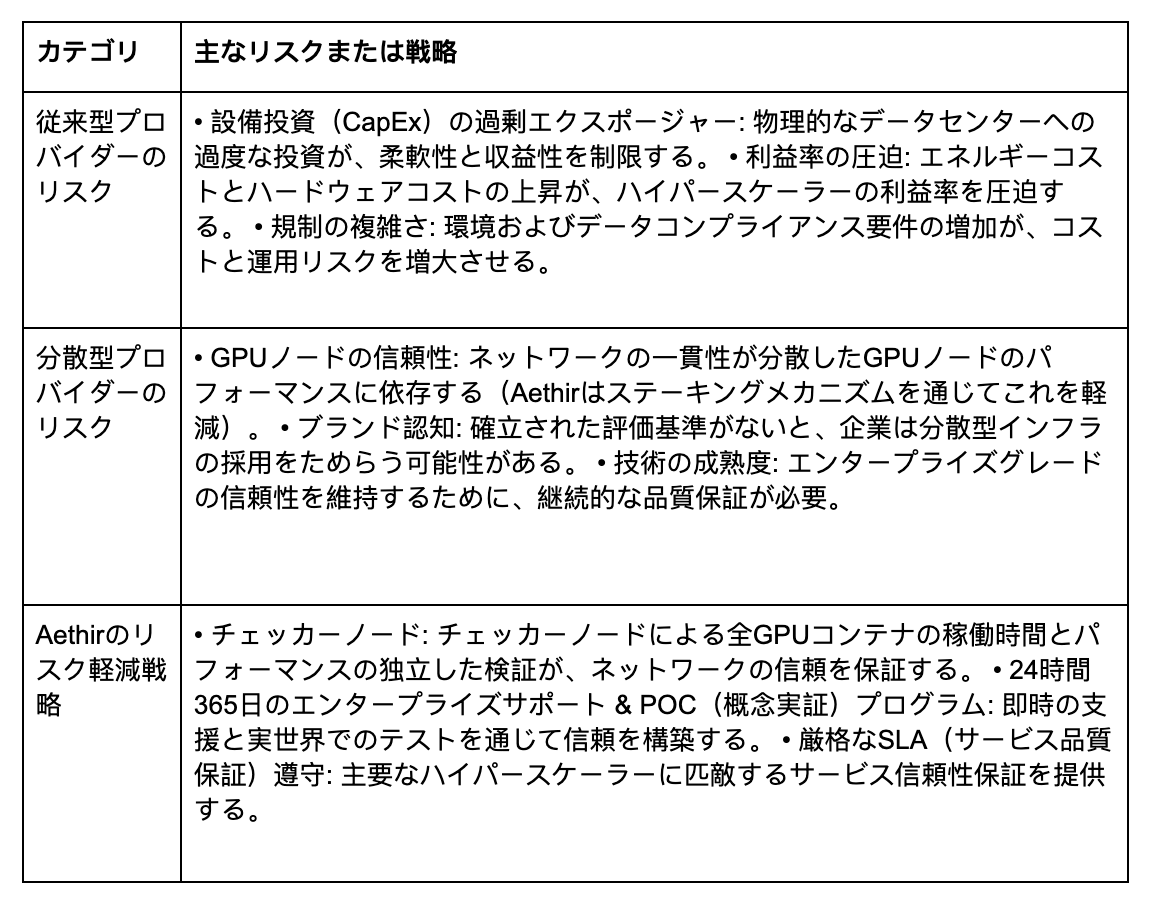
Aethirクラウドホスト:分散型GPUクラウド拡大の原動力
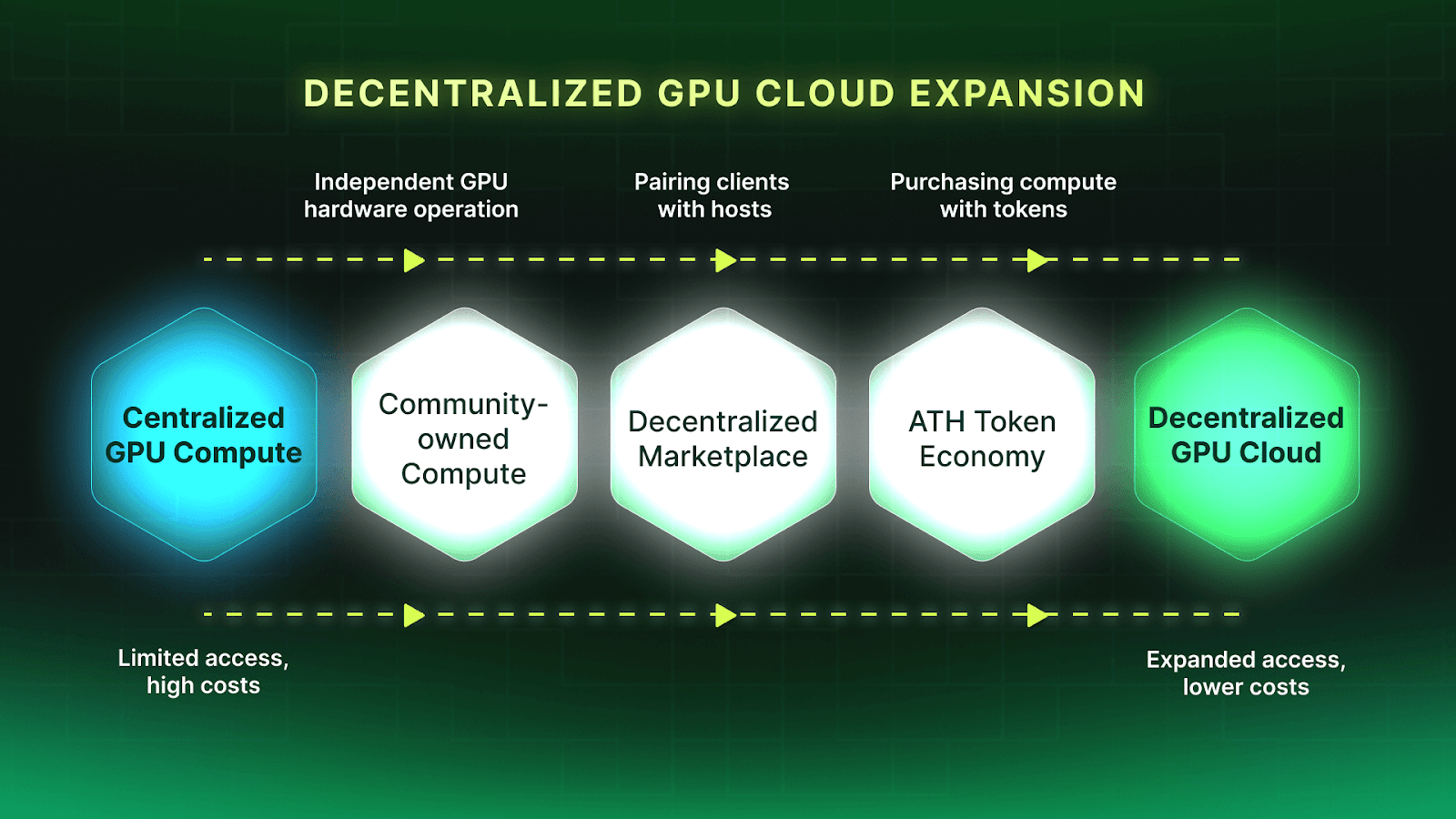
Aethirのグローバルに分散したクラウドホストのネットワークは、分散型GPUクラウドイノベーションの原動力です。AethirのDePINスタック内のすべてのコンピュートはコミュニティによって所有され、GPUハードウェアを独立して操作しAethirのネットワークに接続されているクラウドホストによって稼働しています。
Aethirは分散型GPUコンピュートマーケットプレイスとして機能し、クライアントを最も適切で物理的に最も近い、利用可能なクラウドホストと自動的にペアリングします。
Aethirの経済モデル全体はATHトークンに基づいており、これはコンピュートの購入に使用されます。クラウドホストは収益の80%を受け取り、20%はAethir財団のために留保され、エコシステムの拡大とサービス向上のために投資されます。
中央集権型クラウドとは異なり、Aethirは、Aethirがサポートする高性能GPUをいくつか持っていれば、誰でもコンピュートプロバイダーになることを可能にします。
このビデオでクラウドホストのオンボーディングをご覧いただき、こちらからAethirクラウドホストに応募してください。
クラウドコンピューティングの未来:中央集権型および分散型クラウド技術
クラウドコンピューティングの革命的な変革は、ゼロサム戦争ではありません。それは、複数のモデルが繁栄する「勝者が一部を取る(winner-take-some)」エコシステムです。中央集権型のハイパースケーラーがコンプライアンス重視のエンタープライズセクターを支配し続ける一方で、分散型GPUホスティングは、ハイパースケーラーのコストをかけずに高性能を求めるAI開発者、ゲーム開発者、デジタルスタジオにとって主要なコンピュートソースとなる準備が整っています。
クラウドコンピューティングの未来は、リアルタイムの適応によって定義されます。特にAIの急速な拡大と、エンタープライズグレードのAI GPUコンピューティングへの絶え間ないニーズを考えると、Aethirの分散型GPUクラウドには前例のない成長の機会がもたらされています。
AethirのエンタープライズグレードのベアメタルGPUサービスはこちらでご覧いただけます。
今すぐAethirクラウドホストに応募し、遊休GPUの収益化を始めましょう。
よくある質問(FAQs)
Q: 分散型GPUクラウドホスティングとは何ですか?
A: 分散型GPUクラウドとは、個人やデータセンターがGPUリソースを提供し、集合的にAI、ゲーミング、エンタープライズのワークロードを支える分散型コンピュートネットワークです。
Q: AethirのクラウドはAWSやAzureとどう違いますか?
A: Aethirのグローバル分散モデルは、ハイパースケールのデータセンターを435,000以上のコミュニティ主導のGPUコンテナに置き換えることで、低コスト、迅速なアクセス、優れたスケーラビリティを実現します。
Q: なぜ分散型クラウドホスティングはAIやゲーミングにとって重要なのですか?
A: AIとゲーミングのワークロードは、高いGPU可用性と低遅延を要求します。Aethirの分散型GPUクラウドは、中央集権型データセンターでは太刀打ちできない弾力的なスケーリングと地理的リーチを提供し、リアルタイムレンダリング、モデルトレーニング、推論ワークロードに最適です。
Q: 分散型クラウドコンピューティングの信頼性はどのように保証されていますか?
A: Aethirの分散型GPUクラウドは、91,000以上のチェッカーノードを使用してネットワーク監視と品質検証を行い、すべてのクラウドホストが最適な品質のサービスを提供することを保証します。さらに、すべてのクラウドホストはATHをステークして、GPUの信頼性とネットワークパフォーマンスを一致させる必要があります。
Q: GPU所有者はAethirを通じてどのように収益を得られますか?
A: クラウドホストとして参加することで、GPU所有者はコンピューティングパワーを提供し、それはチェッカーノードによって検証され、パフォーマンスと稼働時間に基づいてATHトークンの報酬を得ます。
分散型GPUクラウドホスティングは、中央集権型コンピューティングの対極にあるのではなく、クラウドインフラの進化形です。次世代のAI開発者、デベロッパー、そして企業は、分散化の効率性とハイパースケーラーの安定性の両方を活用することで繁栄するでしょう。
クラウドの未来は、コンピュートを民主化する者のものです。Aethirは、その未来を今日、構築しています。

